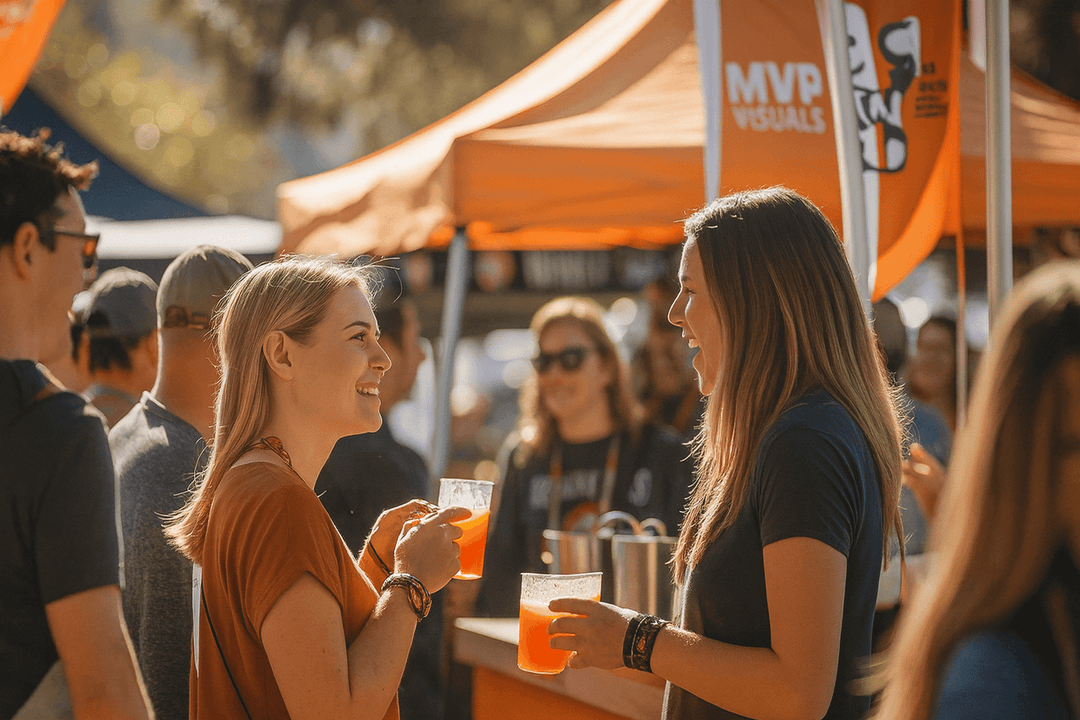Getting the right size canopy tent can make or break your setup. Too small, and your space gets cramped fast. Too big, and you’re wasting budget and square footage.
The right fit depends on how many people you expect, how many tables you’re setting up, and how the space actually needs to function during the event.
Let’s break down the most common pop-up tent sizes - 5x5 to 20x20 feet - with visual references, realistic capacity estimates, and setup ideas based on real event use.
You’ll see how different layouts work, how many people or tables each size can hold comfortably, and when it makes more sense to combine smaller pop-up tents instead of upsizing.
What Sizes Do Canopy Tents Come In?
Pop-up canopy tents are commonly available in six standard sizes: 5x5, 8x8, 10x10, 10x15, 10x20, and 20x20 feet. These dimensions are designed to match typical booth layouts, simplify transport and storage, and allow for flexible modular setups at events.
The 10x10 canopy tent is by far the most popular size - often required or expected at vendor fairs, farmers markets, and trade shows. It’s the standard for single-booth activations and portable displays.
Larger tents, especially anything above 20x20 feet, typically fall outside the “pop-up” category. They require heavier framing systems, longer setup times, and often professional installation.
Below is a quick reference comparing the most common pop-up tent sizes used at events:
Common Canopy Tent Sizes & Weight Ranges
|
Canopy Tent Size (ft) |
Dimensions (inches) |
Typical Weight Range |
|
5' x 5' |
60” x 60” |
20 ~ 30 lbs |
|
8' x 8' |
96” x 96” |
30 ~ 40 lbs |
|
10' x 10' |
120” x 120” |
40 ~ 65 lbs |
|
10' x 15' |
120” x 180” |
55 ~ 80 lbs |
|
10' x 20' |
120” x 240” |
65 ~ 100 lbs |
|
20' x 20' |
240” x 240” |
100 ~ 150+ lbs |
Canopy Tent Capacity Chart
Choosing the right tent size isn’t just about square footage - it’s about how that space translates to people, tables, and function. The chart below compares common pop-up canopy sizes based on comfortable standing and seated capacity, plus how many standard 6-foot or 8-foot tables fit in each.
Comfortable capacity assumes 7 ~ 10 square feet per person - ideal for movement, browsing, and interaction. Packed capacity is possible for short-term use (e.g. photo ops or brief announcements) but not recommended for extended stays.
Canopy Tent Sizes Compared: Capacity, Tables & Use Cases
|
Tent Size |
Capacity (Standing / Seated) |
Tables That Fit (6-ft / 8-ft) |
Recommended Uses |
|
5x5 |
4 / 2 |
0 / 0 |
Promo kiosk, sampling booth |
|
8x8 |
6 / 4 |
1 / 0 |
Small vendor booth, giveaways |
|
10x10 |
10–15 / 8 |
1 / 1 |
Vendor booth, pop-up shop, info tent |
|
10x15 |
15–20 / 12 |
2 / 1 |
Dual table setup, larger displays |
|
10x20 |
20–30 / 16 |
3 / 2 |
Team base, food service, gear setup |
|
20x20 |
30–40 / 24 |
4–5 / 3 |
Marathons, team sports, large exhibits |
Tent Size Breakdowns: Because ‘One Size Fits All’ is a Lie
Some tents barely fit you and a folding chair. Others could host your in-laws, three tables, and a guy running a hot dog stand. The real question isn’t just how big the tent is - it’s what actually fits inside without turning your setup into a fire-code violation.
Below, we break down what each size can realistically hold, how layouts actually work in practice, and what kind of setups make sense for different event needs.
5x5 Canopy Tent

-
Capacity: ~2–3 people comfortably (up to 4 packed)
-
Best for: Promo kiosks, ticket check-ins, or quick handout stations
-
Setup tip: Just enough room for a standing display or one small bistro table. Ideal for tight spaces and short-stay use.
8x8 Canopy Tent

-
Capacity: ~4–5 people comfortably (up to 6 packed)
-
Best for: Solo vendors or compact booth spaces
-
Setup tip: Fits one 6-ft table with enough space to move around, pair it with a custom logo tablecloth to make even a compact booth look polished and professional. A smart pick when footprint is limited but functionality matters.
10x10 Canopy Tent (Most Versatile)

-
Capacity: ~8–10 people comfortably (up to 15 packed)
-
Best for: Standard vendor booths, market stalls, construction sites setup, or info tents
-
Setup tip: Handles 1–2 six-foot tables or a single 8-ft table with room to circulate. Easy to link together for modular setups like 10x20 or 10x30.
10x15 Canopy Tent

-
Capacity: ~12–15 people comfortably (up to 20 packed)
-
Best for: Product demos, multi-table displays
-
Setup tip: Holds 2 six-foot or 1 eight-foot table with extra space for signage, inventory, or gear storage.
10x20 Canopy Tent

-
Capacity: ~18–22 people comfortably (up to 30 packed)
-
Best for: Food vendors, team tents, or merch + info combos
-
Setup tip: Fits 3 six-foot or 2 eight-foot tables with open walking paths. Can be zoned into separate functional areas.
20x20 Canopy Tent

-
Capacity: ~30–35 people comfortably (up to 40 packed)
-
Best for: Anchor tents, registration areas, team HQs
-
Setup tip: Plenty of space for 4–5 six-foot tables, gear, signage, and high-traffic flow. Good for central event hubs or VIP zones.
How to Expand Your Setup Without Going Oversized
Need more space but don’t want to haul a massive frame tent? Combining standard pop-up sizes gives you flexible coverage with easier transport, setup, and teardown. Modular layouts adapt well to odd spaces, shifting weather, and evolving event needs.

Combine 10x10 and 10x20 tents to build a modular setup that fits your space and grows with your event.
-
Two 10x10s side-by-side → creates a 10x20 layout
-
10x10 + 10x20 → adds staging or storage space off a main booth
-
Three 10x10s in a U-shape → creates a central area for seating, browsing, or display
-
L-shape (using 10x10s) → ideal for corner booths or managing foot traffic
Modular canopy tent setups let you scale up without committing to a single oversized structure - and if one tent goes down, your whole setup doesn’t.

This 10x10 and 10x20 canopy tent modular setup for Syracuse Women’s Lacrosse combines full back walls and side panels for added privacy, weather protection, and a clean branded look - perfect for team zones, gear storage, or serving areas.
Choosing the Right Canopy Tent Size Starts Here
The right canopy tent size comes down to more than just square footage. You need to factor in how many people you'll host, how your layout flows, and when it makes more sense to combine smaller tents instead of going bigger.
As a rule of thumb: if your tent needs to serve more than one function - like seating, merch, and registration- modular setups almost always work better than a single oversized tent. They’re easier to transport, configure, and adapt when the event doesn't go exactly to plan.
Have questions? Request a quote - our team will guide you step by step from design to delivery, with no setup fees.



